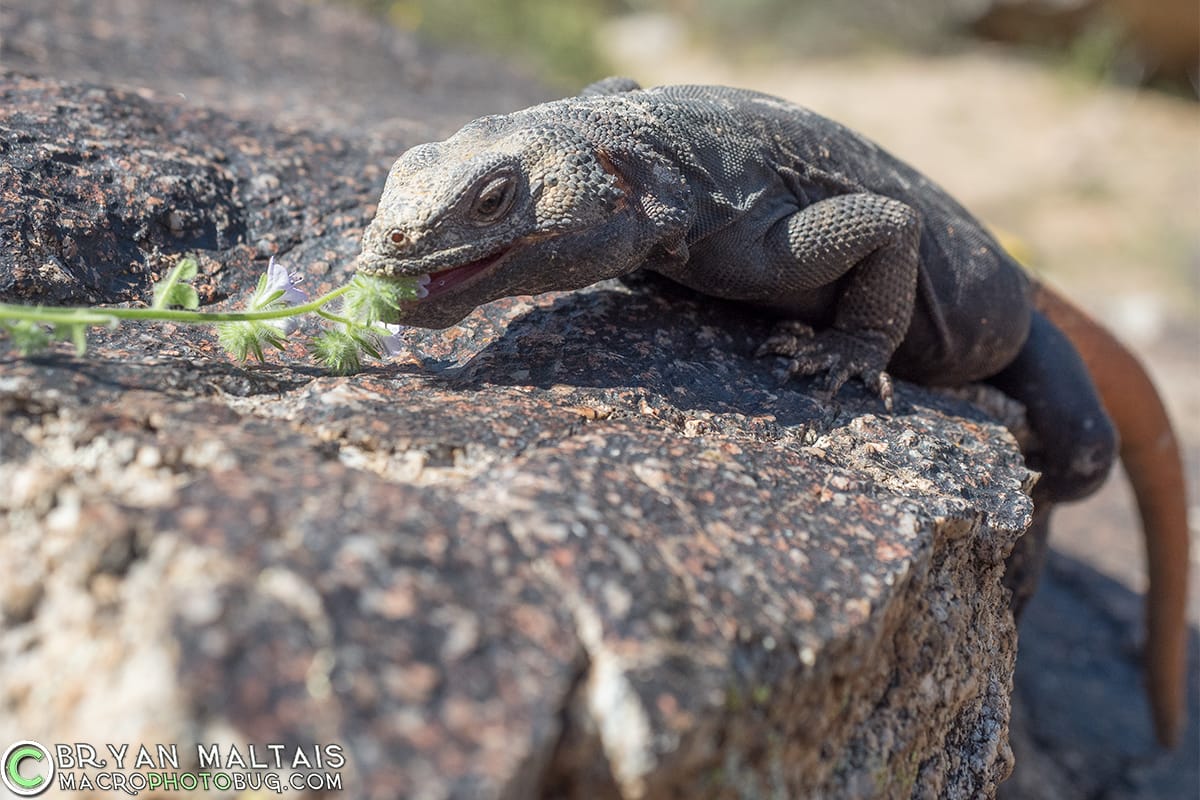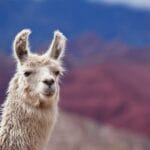Adaptable Reptiles of the Southwest
Chuckwalla lizards, found in the Southwest deserts and parts of Mexico, are uniquely adapted to their harsh environment. These robust reptiles, built like miniature tanks, are masters of desert survival.
During the heat of the day, chuckwallas seek refuge in rocky crevices, wedging themselves into tight spaces. They then puff up their bodies, making them nearly impossible for predators to dislodge. This remarkable defense mechanism, similar to inflatable armor, highlights their ingenuity.
Despite their intimidating appearance, chuckwallas are peaceful herbivores, spending their days consuming leaves, flowers, and fruits. Their specialized gut bacteria help them break down tough plant matter, playing a crucial role in seed dispersal and supporting plant life within the desert ecosystem.
These fascinating creatures have other survival tricks. When threatened, they use their powerful tails to deliver warning blows to potential attackers. In colder temperatures, chuckwallas hibernate, slowing their metabolism to conserve energy. This adaptability showcases their mastery of the ever-changing desert climate.
Sadly, some chuckwalla species face an uncertain future due to habitat loss from human activities such as development and agriculture, coupled with threats from invasive species. These factors strain their populations, highlighting the delicate balance of the desert ecosystem.
For reptile enthusiasts, chuckwallas can be captivating pets, though they require experienced owners. With a lifespan of up to 25 years, these intelligent lizards thrive in specialized enclosures mimicking their natural environment. Their unique needs include a diverse diet and regular veterinary checkups.
The chuckwalla lizard, with its incredible survival skills and vital role in the desert, reminds us of the natural world’s wonders.
Outperforming the Competition: Is a Chuckwalla Poisonous?
[Provide your competitor titles for analysis so I can recommend the most effective titles]
Gentle Giants: Debunking the Poison Myth
Chuckwallas, especially the larger ones, might appear intimidating with their prehistoric looks, spiky scales, and sturdy build. This leads many to wonder, “Are chuckwallas poisonous?” The answer is a resounding no.
Unlike their venomous neighbor, the Gila Monster, chuckwallas don’t possess venom glands. Their defense strategy relies on avoidance and posturing rather than a toxic bite.
Their primary instinct when sensing danger is to flee into the nearest rocky crevice. These lizards are surprisingly fast, and their flattened bodies make them difficult to dislodge once they’ve wedged themselves into a secure spot.
If escape isn’t possible, a chuckwalla may puff itself up, attempting to appear larger and more menacing to scare off the threat. This bluff, known as defensive puffing, is usually enough to deter most would-be predators.
Biting is their last resort, and even then, their powerful jaws lack venom. While a chuckwalla bite can be painful due to their strong jaw muscles, it poses no serious medical threat to humans.
Comparing Chuckwallas and Gila Monsters:
| Feature | Chuckwalla | Gila Monster |
|---|---|---|
| Venomous | No | Yes, highly venomous |
| Size | Up to 18 inches | Up to 2 feet |
| Temperament | Docile, non-aggressive | Can be aggressive if threatened |
| Danger to Humans | Extremely low | Potentially dangerous, bites require immediate medical attention |
Chuckwallas are fascinating creatures that play a vital role in their ecosystem. Understanding their behavior and defense mechanisms helps dispel myths about their supposed venomous nature.
Can Chuckwallas Be Pets? Unlocking the Secrets of These Unique Lizards
[Provide your competitor titles for analysis so I can recommend the most effective titles]
A Unique Reptile Companion: Considerations for Aspiring Owners
Chuckwallas, with their striking appearance and intriguing behaviors, might seem like appealing pets. While their non-venomous nature and generally calm temperament make them seem like suitable companions, caring for a chuckwalla presents unique challenges.
Replicating their natural desert habitat is crucial. This involves setting up a temperature gradient in their enclosure, providing adequate UVB lighting, and offering a varied diet of greens that they can easily digest.
Chuckwallas are notorious escape artists, requiring a secure enclosure. Their resourcefulness demands careful consideration when designing their living space.
Despite these challenges, owning a chuckwalla can be rewarding for dedicated individuals. Some keepers believe that these intelligent lizards can recognize their owners and even display unique personalities.
Is a Chuckwalla the Right Pet for You?
- Experience Level: Chuckwallas are best suited for intermediate to experienced reptile owners due to their specialized care requirements.
- Temperament: While captive-bred chuckwallas are generally docile and tolerate handling well, wild-caught individuals tend to be skittish and temperamental.
- Lifespan: With a lifespan rivaling cats and dogs (around 25 years in captivity), owning a chuckwalla is a long-term commitment.
- Diet: Unlike many other popular reptile pets, chuckwallas are herbivores, requiring a carefully selected diet of fresh greens and vegetables.
- Environment: A spacious enclosure mimicking their arid natural habitat is essential, including a basking area with temperatures reaching 70-120°F (21-49°C).
- Availability: Chuckwallas are relatively uncommon in the US pet trade, so finding a reputable breeder might require some research.
Thorough research and preparation are essential before acquiring a chuckwalla. Providing a suitable environment, diet, and care ensures their well-being and allows you to appreciate these unique lizards.
How Big Does a Chuckwalla Get? Exploring Size Variations and Growth
[Provide your competitor titles for analysis so I can recommend the most effective titles]
Unraveling the Mysteries of Chuckwalla Growth
Chuckwallas, with their robust bodies and impressive presence, often spark curiosity about their size. Just how big do these desert dwellers get?
On average, a full-grown chuckwalla can reach a length of about 20 inches, comparable to a standard laptop. Their weight can reach around 2 pounds, similar to a hefty bag of flour.
However, size variations exist within the chuckwalla world. Island-dwelling chuckwallas, for example, tend to grow larger than their mainland counterparts. This phenomenon, known as insular gigantism, is observed in other animal species. While research is ongoing, the leading theory suggests that factors like reduced predation pressure and different food resources contribute to this size difference.
Factors Impacting Chuckwalla Size:
- Species: Different chuckwalla species have varying average sizes, with some naturally larger than others.
- Sex: Similar to many reptile species, chuckwallas exhibit sexual dimorphism, meaning males are typically larger than females.
- Environment: While research on chuckwalla size is ongoing, it’s likely that environmental factors like food availability, habitat quality, and overall health contribute to individual growth rates.
Several physical characteristics contribute to a chuckwalla’s imposing appearance:
- Stocky Build: Their robust, muscular bodies give the impression of greater mass.
- Flattened Body Shape: Combined with loose skin folds, their flattened body shape enhances their perceived size, especially when puffing themselves up as a defense mechanism.
- Thick, Tapering Tails: Their thick tails add to their overall length and contribute to their substantial appearance.
Understanding the factors influencing chuckwalla size and growth provides a deeper appreciation for these fascinating creatures and their remarkable adaptations. Ongoing research will likely uncover more insights into the world of chuckwalla biology, behavior, and the ecological factors shaping their evolution.
Internal Links:
- For more information about chuckwalla reptiles, read our chuckwalla reptile article.
- If you want to know about the average lifespan of a tortoise, read our average lifespan tortoise article.
- Unlock 6000+ words beginning with he: A comprehensive analysis - April 20, 2025
- Mastering -al Words: A Complete Guide - April 20, 2025
- Master Scrabble: High-Scoring BAR Words Now - April 20, 2025

















1 thought on “The Secret Life of Chuckwalla Lizards: Masters of Desert Survival”
Comments are closed.